 As we saw in Part 1, households are seeing a rise in the cost of living, which is set to accelerate. Inflation in the year to January 2022, as measured by the Consumer Prices Index (CPI), was 5.5%, the highest rate for over 30 years, and it is expected to reach more than 7 per cent by April. This has put great pressure on household budgets, with wage rises for most people being below the rate of price inflation. The poor especially have been hard hit, with many struggling to meet soaring energy, food and transport prices and higher rents.
As we saw in Part 1, households are seeing a rise in the cost of living, which is set to accelerate. Inflation in the year to January 2022, as measured by the Consumer Prices Index (CPI), was 5.5%, the highest rate for over 30 years, and it is expected to reach more than 7 per cent by April. This has put great pressure on household budgets, with wage rises for most people being below the rate of price inflation. The poor especially have been hard hit, with many struggling to meet soaring energy, food and transport prices and higher rents.
In Part 2 we look at the UK government’s response to the situation, a similar response to that in many other countries.
Effects on government finances
 The Chancellor, Rishi Sunak, has stated that the government understands the pressures families are facing with the cost of living. However, rising interest rates mean that it will cost the Treasury considerably more to service the UK’s national debt of more than £2tn.
The Chancellor, Rishi Sunak, has stated that the government understands the pressures families are facing with the cost of living. However, rising interest rates mean that it will cost the Treasury considerably more to service the UK’s national debt of more than £2tn.
Interest payments on index-linked debt are calculated using an alternative measure of inflation, the retail prices index (RPI), which is running at 7.8%, considerably higher than anticipated in last October’s Budget. It is now projected that central government spending on debt interest this financial year will come in at around £69bn, some £11bn higher than the £58bn forecast in the October 2021 Budget and £27bn above the £42bn forecast in the March 2021 Budget.
In addition, it is expected that the latest rise in CPI will increase the chances of the Bank of England raising interest rates and thereby further increasing the costs of servicing national debt. If this is the outcome when its Monetary Policy Committee meets next month, then it would be the third successive time interest rates have been raised.
There is also concern that this, in addition to the direct effects of higher costs, will push more firms towards insolvency. It is argued that if government wanted to prevent this, it would need to cut business taxes in order to boost investment and productivity and to allow businesses to provide annual wage rises that are affordable.
Monetary policy
 The Bank of England’s traditional response to rising inflation is to raise interest rates, which it has done this twice in the past few months. This means that people who have borrowed money could see their monthly payments go up, especially on mortgages tied to Bank Rate.
The Bank of England’s traditional response to rising inflation is to raise interest rates, which it has done this twice in the past few months. This means that people who have borrowed money could see their monthly payments go up, especially on mortgages tied to Bank Rate.
An aim of this policy is to make borrowing more expensive resulting in people spending less. As a result, they will buy fewer things, and prices will stop rising as fast. However, when inflation is caused by external forces, this might have a limited effect on prices and would put a further squeeze on household budgets.
Fiscal policy
Alternatively, the government might choose to cut taxes for consumers on items whose prices are rising quickly. It is taking some measures to reduce the impact of energy price rises. For example, the Treasury has announced that it would provide millions of households with up to £350 to help with their rising energy bills and in April the lowest-paid will see the National Living Wage rise by 6.6%, which is higher than the current inflation rate.
The chief economist of the British Chambers of Commerce has said that tightening monetary policy too quickly risks undermining confidence and the wider recovery, arguing that more needs to be done to limit the unprecedented rise in costs facing businesses, including financial support for those struggling with soaring energy bills and delaying April’s national insurance rise.
Conclusion
 Rising inflation affects all our living standards. It a global issue with causes beyond government control.
Rising inflation affects all our living standards. It a global issue with causes beyond government control.
Rising prices together with planned tax increases mean that real average take-home pay is likely to fall over the coming year. The extra energy costs and tax rises will force families to make savings elsewhere, meaning business revenues may fall, and the economic recovery could be negatively impacted.
However, it is those on low incomes that tend to find it hardest to cope with the rising cost of living. Those impacted the most will be faced with difficult decisions over the coming months as they try to cope with falling real incomes. With food price inflation expected to rise further, a likely rise in interest rates and a further increase in the energy price cap in October, these tough decisions are set to get harder for poorest households in the economy.
Articles
See articles in Part 1
Podcast
Questions
These questions are based on the podcast.
- What elements are there in household energy prices? Which element has gone up most?
- What are the arguments for and against the government delaying the rise in the rate of national insurance by 1.25 percentage points?
- What can be done to help people on modest earnings who earn just too much to receive benefits?
- Are government loans to help people with higher bills a good idea?
- What are the advantages and disadvantages of removing VAT on domestic energy?
 The global battle for fuel is expected to peak this winter. The combination of rising demand and a tightening of supply has sparked concerns of shortages in the market. Some people are worried about another ‘winter of discontent’. Gas prices have risen fivefold in Europe as a whole.
The global battle for fuel is expected to peak this winter. The combination of rising demand and a tightening of supply has sparked concerns of shortages in the market. Some people are worried about another ‘winter of discontent’. Gas prices have risen fivefold in Europe as a whole.
In the UK, consumers are likely to find that the natural gas needed to heat their homes this October will cost at least five times more than it did a year ago. This surge in wholesale gas prices has seen several UK energy suppliers stop trading as they are unable to make a profit. This is because of an energy price cap for some consumers and various fixed price deals they had signed with their customers.
There are thus fears of an energy crisis in the UK, especially if there is a cold winter. There are even warnings that during a cold snap, gas supply to various energy-intensive firms may be cut off. This comes at a time when some of these industries are struggling to make a profit.
Demand and supply
The current situation is a combination of long- and short-term factors. In spring 2020, the demand for gas actually decreased due to the pandemic. This resulted in low gas prices, reduced UK production and delayed maintenance work and investment along global supply chains. However, since early 2021, consumer demand for gas has soared. First, there was an increased demand due to the Artic weather conditions last winter. This was then followed by heatwaves in the USA and Europe over the summer, which saw an increase in the use of air conditioning units. With the increased demand combined with calm weather conditions, wind turbines couldn’t supply enough power to meet demand.
 There has also been a longer-term impact on demand throughout the industry due to the move to cleaner energy. The transitioning to wind and solar has seen a medium-term increase in the demand for gas. There is also a long-term impact of the target for net zero economies in the UK and Europe. This has hindered investors’ willingness to invest in developing supplies of fossil fuels due the fact they could become obsolete over the next few decades.
There has also been a longer-term impact on demand throughout the industry due to the move to cleaner energy. The transitioning to wind and solar has seen a medium-term increase in the demand for gas. There is also a long-term impact of the target for net zero economies in the UK and Europe. This has hindered investors’ willingness to invest in developing supplies of fossil fuels due the fact they could become obsolete over the next few decades.
Nations have also been unable to build up enough supplies for winter. This is partly due to Europe’s domestic gas stocks having declined by 30% per cent in the past decade. This heightened situation is leading to concerns that there will be black-outs or cut-offs in gas this winter.
Importation of gas
 A concern for the UK is that it has scant storage facilities with no long-term storage. The UK currently has very modest amounts of storage – less than 6% of annual demand and some five times less than the average in the rest of Europe. It has been increasingly operating a ‘just-in-time model’, which is more affected by short-term price fluctuations in the wholesale gas market. With wind power generation remaining lower than average during summer 2021, more gas than usual has been used to generate electricity, leaving less gas to go into storage.
A concern for the UK is that it has scant storage facilities with no long-term storage. The UK currently has very modest amounts of storage – less than 6% of annual demand and some five times less than the average in the rest of Europe. It has been increasingly operating a ‘just-in-time model’, which is more affected by short-term price fluctuations in the wholesale gas market. With wind power generation remaining lower than average during summer 2021, more gas than usual has been used to generate electricity, leaving less gas to go into storage.
However, some argue that the problem is not just the UK’s physical supply of gas but demand for gas from elsewhere. Around half of the UK’s supply comes from its own production sites, while the rest is piped in from Europe or shipped in as liquefied natural gas (LNG) from the USA, Qatar and Russia. In 2019, the UK imported almost 20% of its gas through LNG shipments. However, Asian gas demand has grown rapidly, expanding by 50% over the past decade. This has meant that LNG has now become much harder to secure.
The issue is the price the UK has to pay to continue receiving these supplies. Some in the gas industry believe the price surge is only temporary, caused by economic disruptions, while many others say it highlights a structural weakness in a continent that has become too reliant on imported gas. It can be argued that the gas crisis has highlighted the lack of a coherent strategy to manage the gas industry as the UK transitions to a net zero economy. The lack of any industry investment in new capacity suggests that there is currently no business case for new long-term storage in the UK, especially as gas demand is expected to continue falling over the longer term.
Impact on consumers and industry
 Gas prices for suppliers have increased fivefold over the past year. Therefore, many companies face a considerable rise in their bills. MSome may need to reduce or pause production – or even cease trading – which could cause job losses. Alternatively, they could pass on their increased costs to customers by charging them higher prices. Although energy-intensive industries are particularly exposed, every company that has to pay energy bills will be affected. Due to the growing concerns about the security of winter gas supplies those industries reliant on gas, such as the fertiliser industry, are restricting production, threatening various supply chains.
Gas prices for suppliers have increased fivefold over the past year. Therefore, many companies face a considerable rise in their bills. MSome may need to reduce or pause production – or even cease trading – which could cause job losses. Alternatively, they could pass on their increased costs to customers by charging them higher prices. Although energy-intensive industries are particularly exposed, every company that has to pay energy bills will be affected. Due to the growing concerns about the security of winter gas supplies those industries reliant on gas, such as the fertiliser industry, are restricting production, threatening various supply chains.
Most big domestic gas suppliers buy their gas months in advance, meaning they will most likely pass on the higher price rises they have experienced in the past few months. The increased demand and decreased supply has already meant meant that customers have faced higher prices for their energy. The UK has been badly hit because it’s one of Europe’s biggest users of natural gas – 85% of homes use gas central heating – and it also generates a third of the country’s electricity.
The rising bills are particularly an issue for those customers on a variable tariff. About 15 million households have seen their energy bills rise by 12% since the beginning of October due to the rise in the government’s energy price cap calculated by the regulator, Ofgem. A major concern is that this increase in bills comes at a time when the need to use more heating and lighting is approaching. It also coincides with other price rises hitting family budgets and the withdrawal of COVID support schemes.
Government intervention – maximum pricing
If the government feels that the equilibrium price in a particular market is too high, it can intervene in the market and set a maximum price. When the government intervenes in this way, it sets a price ceiling on certain basic goods or services and does not permit the price to go above that set limit. A maximum price is normally set for reasons of fairness and to benefit consumers on low incomes. Examples include energy price caps to order to control fuel bills, rent controls in order to improve affordability of housing, a cap on mobile roaming charges within the EU and price capping for regional monopoly water companies.
The energy price cap
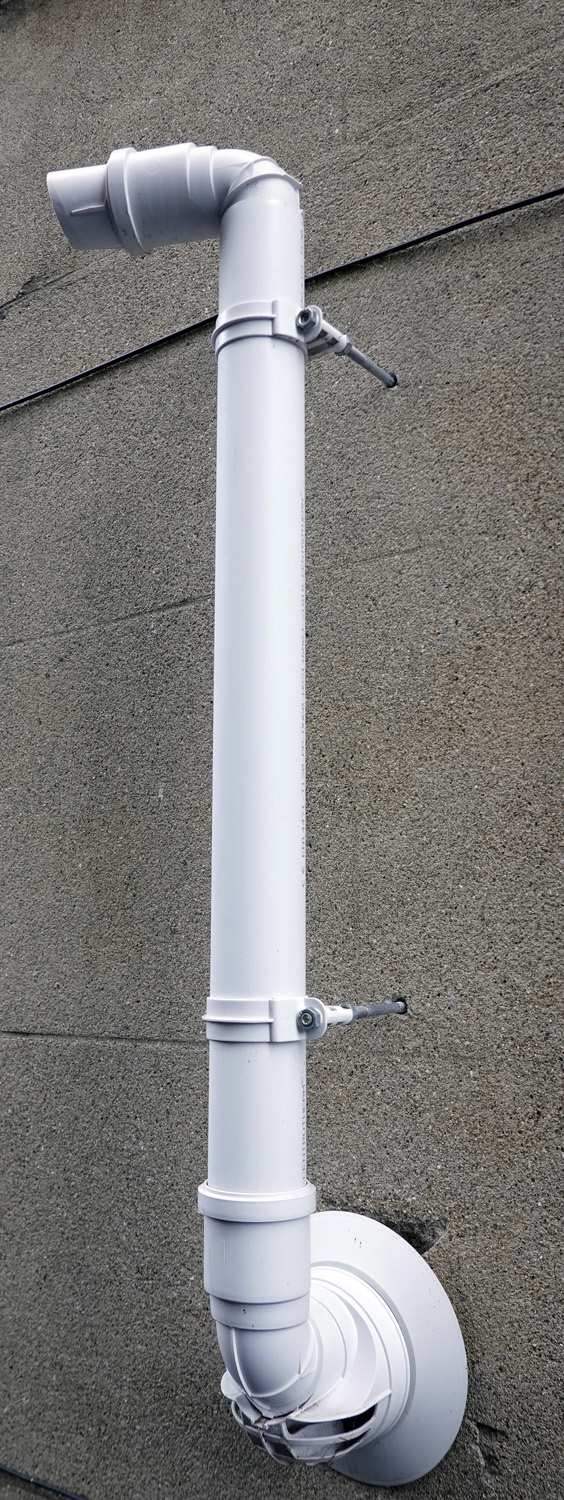 Even without the prospect of a colder than normal winter, bills are still increasing. October’s increase in the fuel cap means that many annual household fuel bills will rise by £135 or more. The price cap sets the maximum price that suppliers in England, Wales and Scotland can charge domestic customers on a standard, or default tariff. The cap has come under the spotlight owing to the crisis among suppliers, which has seen eleven firms fold, with more expected.
Even without the prospect of a colder than normal winter, bills are still increasing. October’s increase in the fuel cap means that many annual household fuel bills will rise by £135 or more. The price cap sets the maximum price that suppliers in England, Wales and Scotland can charge domestic customers on a standard, or default tariff. The cap has come under the spotlight owing to the crisis among suppliers, which has seen eleven firms fold, with more expected.
The regulator Ofgem sets a price cap for domestic energy twice a year. The latest level came into place on 1 October. It is a cap on the price of energy that suppliers can charge. The price cap is based on a broad estimate of how much it costs a supplier to provide gas and electricity services to a customer. The calculation is mainly made up of wholesale energy costs, network costs such as maintaining pipes and wires, policy costs including Government social and environmental schemes, operating costs such as billing and metering services and VAT. Therefore, suppliers can only pass on legitimate costs of supplying energy and cannot charge more than the level of the price cap, although they can charge less. A household’s total bill is still determined by how much gas and electricity is used.
- Those on standard tariffs, with typical household levels of energy use, will see an increase of £139.
- People with prepayment meters, with average energy use, will see an annual increase of £153.
- Households on fixed tariffs will be unaffected. However, those coming to the end of a contract are automatically moved to a default tariff set at the new level.
Ordinarily, customers are able to shop around for cheaper deals, but currently, the high wholesale prices of gas means that cheaper deals are not available.
Despite the cap limiting how much providers can raise prices, the current increase is the biggest (and to the highest amount) since the cap was introduced in January 2019. As providers are scarcely making a profit on gas, there are concerns that a further increase in wholesale prices will cause more suppliers to be forced out of business. Ofgem said that the cap is likely to go up again in April, the next time it is reviewed.
Conclusion
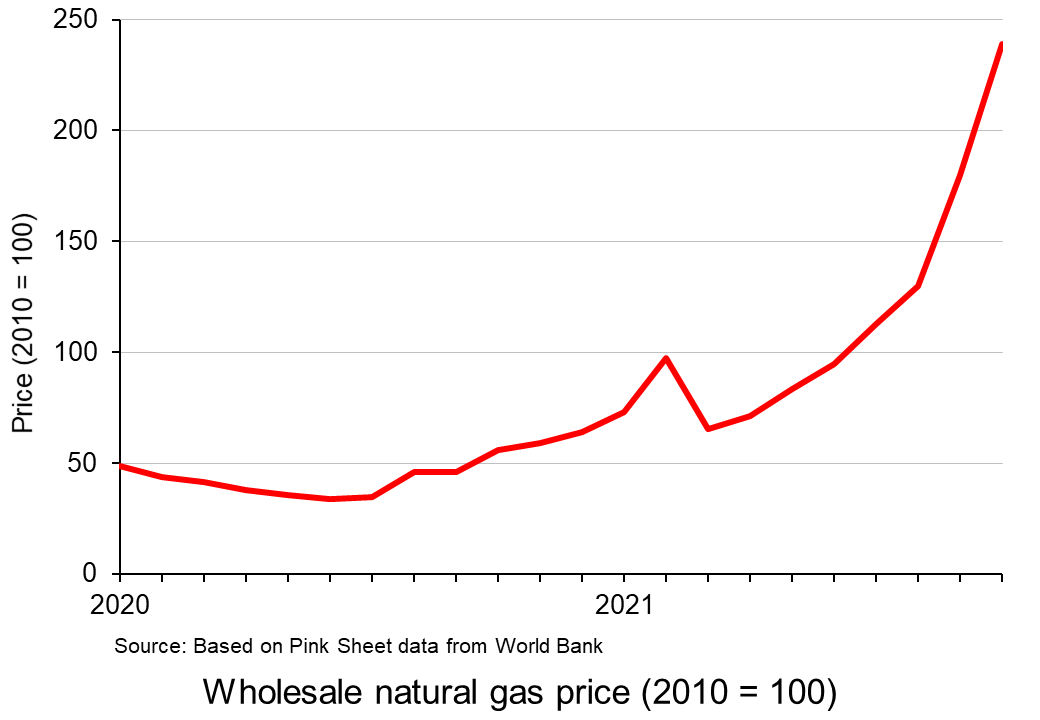 The record prices being paid by suppliers and deficits in gas supply across the world have stoked fears that the energy crisis will get worse. It comes at a time when households are already facing rising bills, while some energy-intensive industries have started to slow production. This has started to dent optimism around the post-pandemic economic recovery.
The record prices being paid by suppliers and deficits in gas supply across the world have stoked fears that the energy crisis will get worse. It comes at a time when households are already facing rising bills, while some energy-intensive industries have started to slow production. This has started to dent optimism around the post-pandemic economic recovery.
Historically, UK governments have trusted market mechanisms to deliver UK gas security. However, consumers are having to pay the cost of such an approach. The price cap has meant the UK’s gas bills have until now been typically lower than the EU average. However, the rise in prices comes on top of other economic problems such as labour shortages and increasing food prices, adding up to an unwelcome rise in the cost of living.
Video
Articles
UK government/Ofgem
Questions
- Using a supply and demand diagram, illustrate what has happened in the energy market over the past year.
- What are the advantages and disadvantages of government intervention in a free market?
- Explain why it is necessary for the regulator to intervene in the energy market.
- Using the concept of maximum pricing, illustrate how the price cap works.
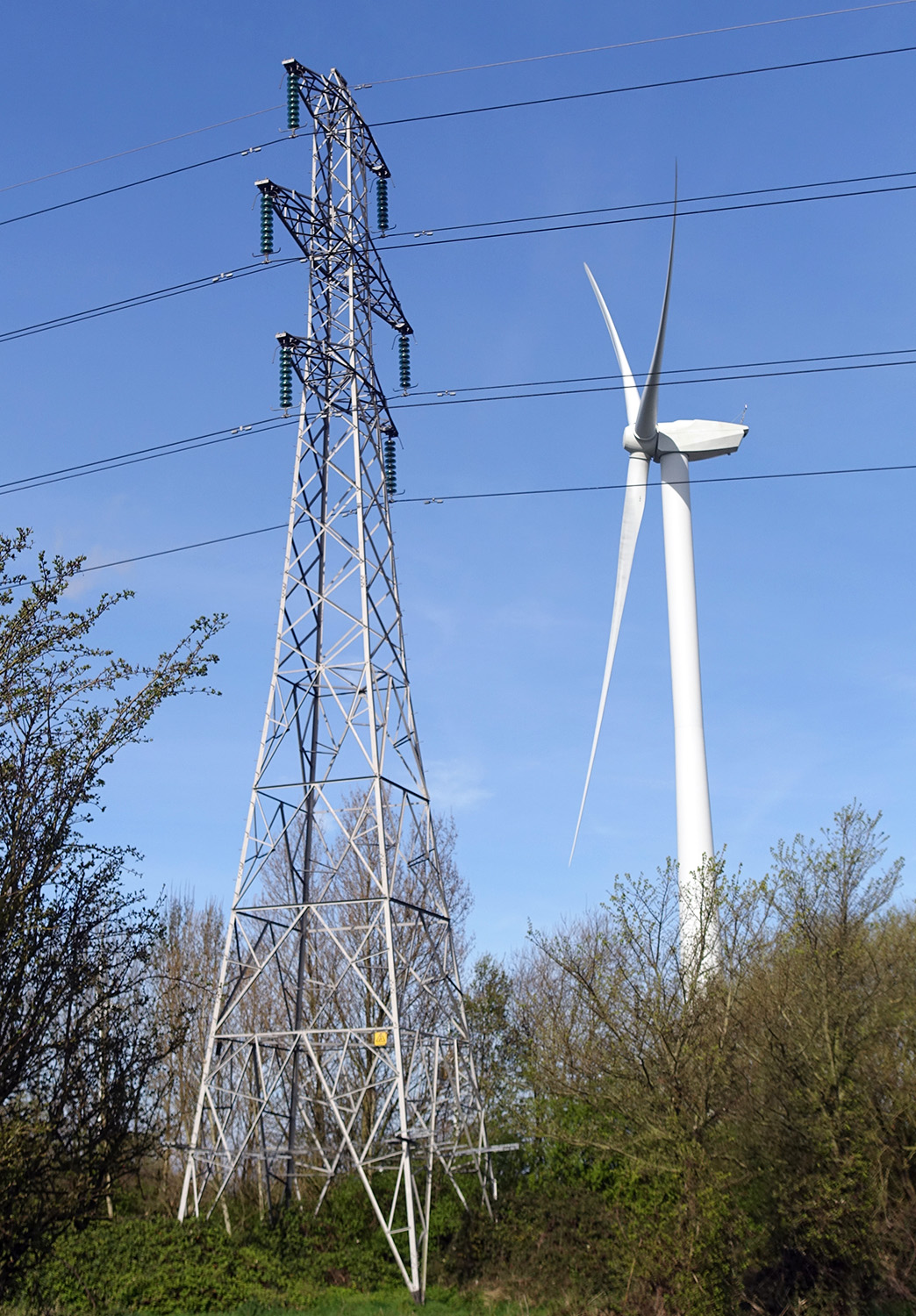 Following concerns about the market power of the Big Six energy suppliers in the UK and high prices for gas and electricity, the industry regulator, Ofgem, referred the industry to the Competition and Markets Authority (CMA) in June 2014. The CMA published its final report in June 2016. This argued that while there was sufficient potential for competition, consumers nevertheless needed further encouragement to switch suppliers. This would strengthen competition in the market.
Following concerns about the market power of the Big Six energy suppliers in the UK and high prices for gas and electricity, the industry regulator, Ofgem, referred the industry to the Competition and Markets Authority (CMA) in June 2014. The CMA published its final report in June 2016. This argued that while there was sufficient potential for competition, consumers nevertheless needed further encouragement to switch suppliers. This would strengthen competition in the market.
To encourage switching, the CMA proposed the creation of a database that would include the details of customers who have been on a supplier’s standard variable tariff (SVT) for three or more years. Competitor energy suppliers would have access to this database to offer better deals for these customers.
There had already been calls for price caps to be imposed on suppliers. For example, in the run-up to the 2015 general election, the then Labour leader, Ed Miliband, proposed imposing a price freeze. This was criticised by the Conservatives for being too anti-market, that it would encourage energy companies to raise prices prior to the freeze and that it would be of no benefit in times of falling wholesale energy prices (which was the position in 2015).
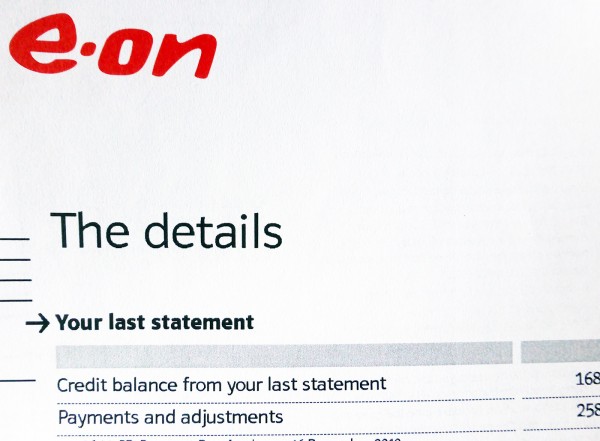 Indeed, in its 2016 report, the CMA recommended price caps only for the 16% of people on prepayment meters and these would be variable caps not freezes. This was followed in February 2017, by Ofgem’s announcement that a temporary price cap for such customers would come into effect in April 2017. The level of the cap would vary by meter type and region. It would also be reviewed every six months to reflect changes in costs and remain in place until 2020. There would be no cap on other customers.
Indeed, in its 2016 report, the CMA recommended price caps only for the 16% of people on prepayment meters and these would be variable caps not freezes. This was followed in February 2017, by Ofgem’s announcement that a temporary price cap for such customers would come into effect in April 2017. The level of the cap would vary by meter type and region. It would also be reviewed every six months to reflect changes in costs and remain in place until 2020. There would be no cap on other customers.
But in the run-up to the 2017 election, the Conservatives announced that they would, after all, introduce a price cap on SVTs – 66% of customers are on such tariffs. Before the details were announced, there was much speculation as to what form such a cap would take? It would not be a simple freeze. But there was debate as to whether caps would vary with wholesale costs or whether they would be relative to the company’s lowest tariffs or to those of its rivals.
As it turned out, the proposal was for a cap on standard variable tariffs. It would be set by Ofgem and reviewed every six months. The cap would be based on the cheapest standard variable tariffs in each part of the UK, taking into account the variable costs for transporting energy there. Ofgem will adjust the cap every six months to reflect changes in the wholesale cost of energy.
Articles before details were anniunced
U.K. Energy Industry Faults May’s Election Pledge to Cap Prices Bloomberg, Rakteem Katakey (23/4/17)
Conservatives promise to cap prices in UK energy market Financial Times, Jim Pickard and Nathalie Thomas (23/4/17)
How might an energy price cap work? BBC News, Brian Milligan (24/4/17)
UK government vows strong action to rein in energy companies The Guardian, Adam Vaughan (19/4/17)
Energy bills: what’s the difference between Tory cap and Miliband freeze? The Guardian, Adam Vaughan (23/4/17)
Capping energy prices? Still a bad idea Adam Smith Institute blogs, Sam Dumitriu (25/4/17)
Bulb becomes ‘first’ provider to cut energy prices this year Moneywise (24/4/17)
Experts slam Conservative plans to cap energy bills as ‘clumsy and counterproductive’ The Telegraph, Lauren Davidson (23/4/17)
Capping energy tariffs isn’t a one-way ticket to Venezuelan-style economic ruin Independent, Ben Chu (25/4/17)
Articles after details were anniunced
Conservatives defend plans to cap UK energy bills Financial Times, Jim Pickard and Nathalie Thomas (9/5/17)
What is the energy price cap – and what does it mean for bills? The Telegraph, Jillian Ambrose (9/5/17)
The new energy price cap con? The Telegraph, Jillian Ambrose (9/5/17)
May defends plan to cap ‘rip-off energy bills’ BBC News (9/5/17)
Q&A: The Tory plan to cap energy prices BBC News, Brian Milligan (9/5/17)
Energy prices could still go up under Theresa May’s price cap plans, admits Business Secretary Greg Clark Independent, Rob Merrick (9/5/17)
Tory claims over energy price cap are just hot air The Guardian, Nils Pratley (9/5/17)
Video and audio
 UK government energy price cap ‘sheer politics’: Bernstein CNBC, Deepa Venkateswaran and Andrew Sentance (25/4/17)
UK government energy price cap ‘sheer politics’: Bernstein CNBC, Deepa Venkateswaran and Andrew Sentance (25/4/17)
 Energy UK: price cap could backfire Sky News, Lawrence Slade (24/4/17)
Energy UK: price cap could backfire Sky News, Lawrence Slade (24/4/17)
 Scottish Power: Capping prices ‘damages customers’ BBC News, Keith Anderson (24/4/17)
Scottish Power: Capping prices ‘damages customers’ BBC News, Keith Anderson (24/4/17)
 Tories to pledge energy bill cap BBC News, Michael Fallon (24/4/17)
Tories to pledge energy bill cap BBC News, Michael Fallon (24/4/17)
 Tories: Energy cap will protect vulnerable people BBC Today Programme, Business Secretary Greg Clark (9/5/17)
Tories: Energy cap will protect vulnerable people BBC Today Programme, Business Secretary Greg Clark (9/5/17)
 Energy cap: good or bad for consumers? Sky News, Stephen Fitzpatrick and James Kirkup (9/5/17)
Energy cap: good or bad for consumers? Sky News, Stephen Fitzpatrick and James Kirkup (9/5/17)
Questions
- What scope is there for tacit collusion between the Big Six energy suppliers?
- What is meant by the RPI–X price cap? How does it differ from proposals being considered by the government?
- Why are people often reluctant to switch energy supplier?
- How could people be encouraged to switch supplier?
- What are the advantages and disadvantages of imposing a price cap for SVTs (a) relative to costs; (b) relative to lower-priced tariffs?
- Comment on Centrica’s chief executive officer Iain Conn’s statement that “price regulation will result in reduced competition and choice, and potentially impact customer service”.
- Comment on the statement by Lawrence Slade, chief executive officer of Energy UK, that intervention would create “huge uncertainty around government intentions, potentially putting at risk the billions in investment and jobs needed to renew our energy system”.
- Would an announcement of the introduction of a price cap in the near future necessarily encourage energy companies to raise their price now?
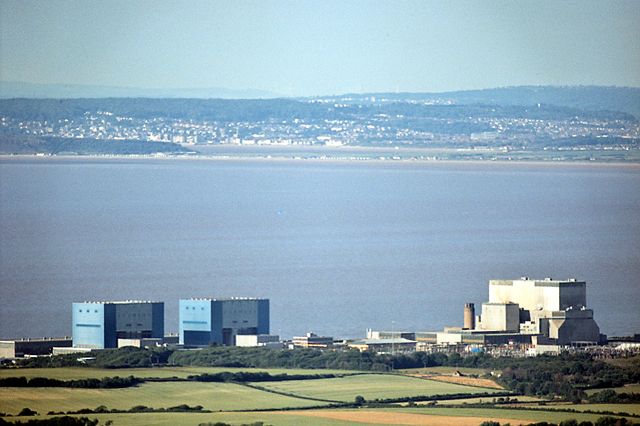 The UK government has finally given the go-ahead to build the new Hinkley C nuclear power station in Somerset. It will consist of two European pressurised reactors, a relatively new technology. No EPR plant has yet been completed, with the one in the most advanced stages of construction at Flamanville in France, having experienced many safety and construction problems. This is currently expected to be more than three times over budget and at least six years behind its original completion date of 2012.
The UK government has finally given the go-ahead to build the new Hinkley C nuclear power station in Somerset. It will consist of two European pressurised reactors, a relatively new technology. No EPR plant has yet been completed, with the one in the most advanced stages of construction at Flamanville in France, having experienced many safety and construction problems. This is currently expected to be more than three times over budget and at least six years behind its original completion date of 2012.
The Hinkley C power station, first proposed in 2007, is currently estimated to cost £18 billion. This cost will be borne entirely by its builder, EDF, the French 85% state-owned company, and its Chinese partner, CGN. When up and running – currently estimated at 2025 – it is expected to produce around 7% of the UK’s electricity output.
On becoming Prime Minister in July 2016, Theresa May announced that the approval for the plant would be put on hold while further investigation of its costs, benefits, 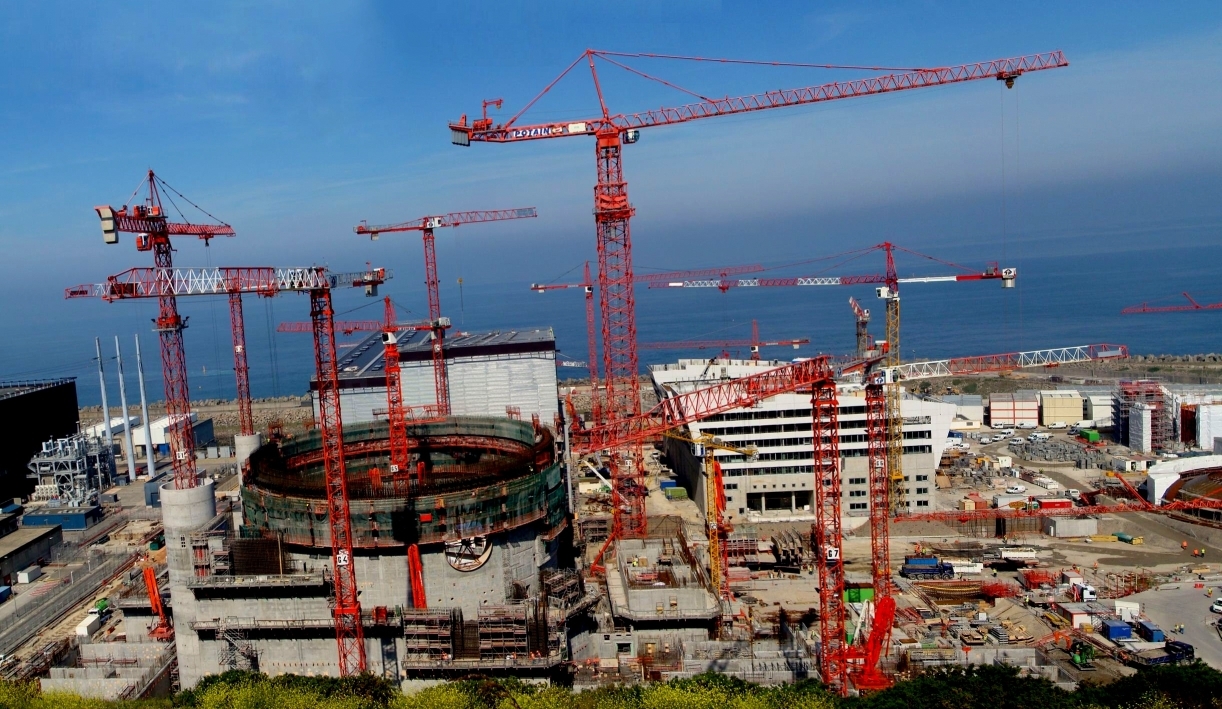 security concerns, technological issues and safeguards was conducted. This has now been completed and approval has been granted subject to new conditions. The main one is that the government “will be able to prevent the sale of EDF’s controlling stake prior to the completion of construction”. This will allow the government to prevent change of ownership during the construction phase. Thus, for example, EDF, would not be allowed to sell its share of Hinkley C to CGN, which currently has a one-third share in the project. EDF and CGN have accepted the new terms.
security concerns, technological issues and safeguards was conducted. This has now been completed and approval has been granted subject to new conditions. The main one is that the government “will be able to prevent the sale of EDF’s controlling stake prior to the completion of construction”. This will allow the government to prevent change of ownership during the construction phase. Thus, for example, EDF, would not be allowed to sell its share of Hinkley C to CGN, which currently has a one-third share in the project. EDF and CGN have accepted the new terms.
After Hinkley the government will have a ‘golden share’ in all future nuclear projects. “This will ensure that significant stakes cannot be sold without the Government’s knowledge or consent.”
In return for their full financing of the project, the government has guaranteed EDF and CGN a price of £92.50 per megawatt hour of electricity (in 2012 prices). This price will be borne by consumers. It will rise with inflation from now and over the first 35 years of the power station’s operation. It is expected that the Hinkley C will have a life of 60 years.
Critics point out that this guaranteed ‘strike price’ is more than double the current wholesale price of electricity and, with the price of renewables falling as technology improves, it will be an expensive way to meet the UK’s electricity needs and cut carbon emissions.
Those in favour argue that it is impossible to predict electricity prices into the distant future and that the certainty this plant will give is worth the high price by current standards.
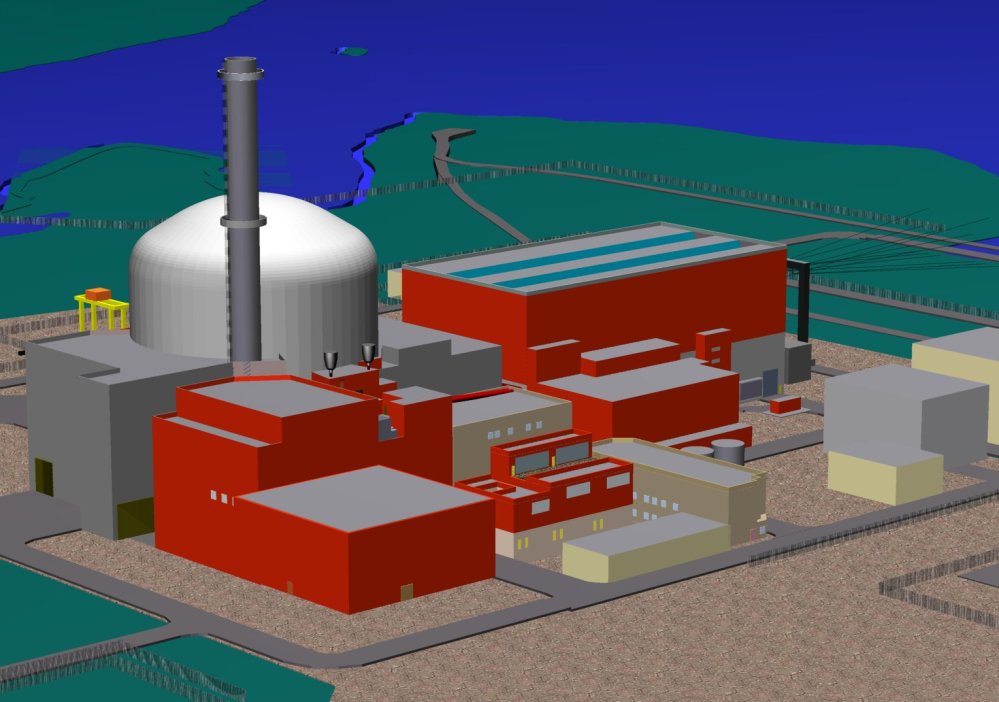
To assess the desirability of the plant requires an assessment of its costs and benefits. In principle, this is a relatively simple process of identifying and measuring the costs and benefits, including external costs and benefits; discounting future costs and benefits to give them a present value; weighting them by their probability of occurrence; then calculating whether the net present value is positive or negative. A sensitivity analysis could also be conducted to show just how sensitive the net present value would be to changes in the value of specific costs or benefits.
In practice the process is far from simple – largely because of the huge uncertainty over specific costs and benefits. These include future wholesale electricity prices, unforeseen problems in construction and operation, and a range of political issues, such as pressure from various interest groups, and attitudes and actions of EDF and CGN and their respective governments, which will affect not only Hinkley C but other future power stations.
The articles look at the costs and benefits of this, the most expensive construction project ever in the UK, and possibly on Earth..
Articles
Hinkley Point: UK approves nuclear plant deal BBC News (15/9/16)
Hinkley Point: What is it and why is it important? BBC News, John Moylan (15/9/16)
 ‘The case hasn’t changed’ for Hinkley Point C BBC Today Programme, Malcolm Grimston (29/7/16)
‘The case hasn’t changed’ for Hinkley Point C BBC Today Programme, Malcolm Grimston (29/7/16)
U.K. Approves EDF’s £18 Billion Hinkley Point Nuclear Project Bloomberg, Francois De Beaupuy (14/9/16)
Hinkley Point C nuclear power station gets government green light The Guardian, Rowena Mason and Simon Goodley (15/9/16)
Hinkley Point C: now for a deep rethink on the nuclear adventure? The Guardian, Nils Pratley (15/9/16)
Hinkley Point C finally gets green light as Government approves nuclear deal with EDF and China The Telegraph, Emily Gosden (15/9/16)
UK gives go-ahead for ‘revised’ £18bn Hinkley Point plant Financial Times, Andrew Ward, Jim Pickard and Michael Stothard (15/9/16)
Hinkley Point: Is the UK getting a good deal? Financial Times, Andrew Ward (15/9/16)
Hinkley Point is risk for overstretched EDF, warn critics Financial Times, Michael Stothard (15/9/16)
Hinkley C must be the first of many new nuclear plants The Conversation, Simon Hogg (16/9/16)
Report
Nuclear power in the UK National Audit Office, Sir Amyas Morse, Comptroller and Auditor General (12/7/16)
Questions
- Summarise the arguments for going ahead with Hinkley C.
- Summarise the objections to Hinkley C.
- What categories of uncertain costs and uncertain benefits are there for the project?
- Is the project in EDF’s interests?
- How will the government’s golden share system operate?
- How should the discount rate be chosen for discounting future costs and benefits from a project such as Hinkley C?
- What factors will determine the wholesale price of electricity over the coming years? In real terms, do you think it is likely to rise or fall? Explain.
- If nuclear power has high fixed costs and low marginal costs, how does this affect how much nuclear power stations should be used in a situation of daily and seasonal fluctuations in demand?
- How could ‘smart grid’ technology smooth out peaks and troughs in electricity supply and demand? How does this affect the relative arguments about nuclear power versus renewables?
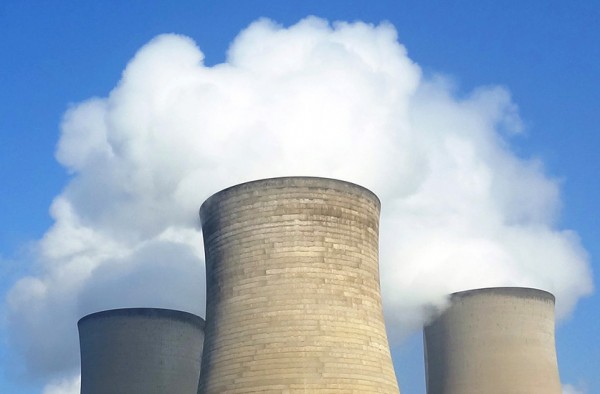 According to a recent IMF Survey Magazine article, Counting the Cost of Energy Subsidies, world-wide energy subsidies in 2015 account for $5.3 trillion or 6.5% of global GDP. The article summarises findings of an IMF working paper (see link below), which provides estimates by country, product (e.g. coal and oil) and component (e.g. global warming, local air pollution and congestion) in an Excel file
According to a recent IMF Survey Magazine article, Counting the Cost of Energy Subsidies, world-wide energy subsidies in 2015 account for $5.3 trillion or 6.5% of global GDP. The article summarises findings of an IMF working paper (see link below), which provides estimates by country, product (e.g. coal and oil) and component (e.g. global warming, local air pollution and congestion) in an Excel file
The working paper argues that energy subsidies are both larger and more pervasive than previously thought. According to the IMF Survey Magazine:
Eliminating global energy subsidies could reduce deaths related to fossil-fuel emissions by over 50 percent and fossil-fuel related carbon emissions by over 20 percent. The revenue gain from eliminating energy subsidies is projected to be $2.9 trillion (3.6 percent of global GDP) in 2015. This offers huge potential for reducing other taxes or strengthening revenue bases in countries where large informal sector constrains broader fiscal instruments.
In interpreting the findings it is important to understand how the term ‘subsidies’ is being used. 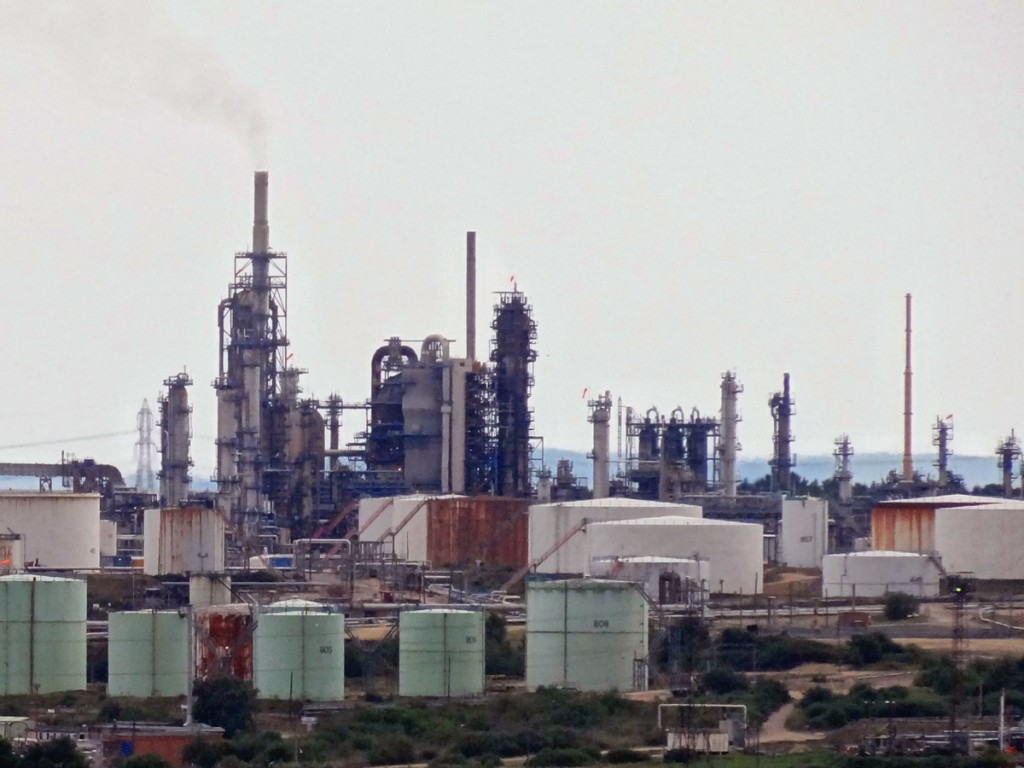 According to the report, most of the $5.3 trillion “arises from countries setting energy taxes below levels that fully reflect the environmental damage associated with energy consumption.”
According to the report, most of the $5.3 trillion “arises from countries setting energy taxes below levels that fully reflect the environmental damage associated with energy consumption.”
In other words, the term subsidy is being used whenever taxes do not fully account for the negative externalities associated with extracting and burning fossil fuels. Perhaps a better term would be ‘under-taxing’ rather than ‘subsidising’. Nevertheless the scale of not internalising externalities is huge. As Lord Nicholas Stern (author of the 2006 Stern Review on the Economics of Climate Change) says:
“The failure to reflect the real costs of fossil fuels in prices and policies means that the lives and livelihoods of billions of people around the world are being threatened by climate change and local air pollution.”
But, while not taxing external costs account for more than 80% of the underpricing of fossil fuel energy, some three-quarters of these external costs relate to local environmental damage, rather than international damage such as global warming. Thus charging for these external costs would benefit primarily the local population, as well as generating revenues, and thus provides a strong argument for governments raising energy prices through increased taxes or reduced subsidies.
So which countries are the major culprits in ‘subsidising’ fossil fuels? What specific measures does the IMF recommend to tackle the problem and what countries are addressing the problem and in what ways? The working paper and articles address these questions.
Articles
Counting the Cost of Energy Subsidies IMF Survey Magazine (17/7/15)
G20 countries pay over $1,000 per citizen in fossil fuel subsidies, says IMF The Guardian, Damian Carrington (4/8/15)
 Fossil fuels subsidised by $10m a minute, says IMF The Guardian, Damian Carrington (18/5/15)
Fossil fuels subsidised by $10m a minute, says IMF The Guardian, Damian Carrington (18/5/15)
Working Paper
How Large Are Global Energy Subsidies? IMF Working Paper, David Coady, Ian Parry, Louis Sears, and Baoping Shang (May 2015)
Questions
- Explain how energy subsidies are defined in the IMF working paper.
- What measurement problems are there in calculating the size of the ‘subsidies’?
- Draw a diagram to show how the under taxing of fossil fuel usage leads to a greater than socially optimum level of consumption of fossil fuels.
- What specific policies are pursued by the four biggest fossil fuel subsidising countries?
- What political problems are there in persuading countries to reduce fossil fuel subsidies/increase fossil fuel taxes.
- Is there a relatively high or low income elasticity of demand for energy? What are the implications of this for different income groups of policies to hold down energy prices?
 As we saw in Part 1, households are seeing a rise in the cost of living, which is set to accelerate. Inflation in the year to January 2022, as measured by the Consumer Prices Index (CPI), was 5.5%, the highest rate for over 30 years, and it is expected to reach more than 7 per cent by April. This has put great pressure on household budgets, with wage rises for most people being below the rate of price inflation. The poor especially have been hard hit, with many struggling to meet soaring energy, food and transport prices and higher rents.
As we saw in Part 1, households are seeing a rise in the cost of living, which is set to accelerate. Inflation in the year to January 2022, as measured by the Consumer Prices Index (CPI), was 5.5%, the highest rate for over 30 years, and it is expected to reach more than 7 per cent by April. This has put great pressure on household budgets, with wage rises for most people being below the rate of price inflation. The poor especially have been hard hit, with many struggling to meet soaring energy, food and transport prices and higher rents. The Chancellor, Rishi Sunak, has stated that the government understands the pressures families are facing with the cost of living. However, rising interest rates mean that it will cost the Treasury considerably more to service the UK’s national debt of more than £2tn.
The Chancellor, Rishi Sunak, has stated that the government understands the pressures families are facing with the cost of living. However, rising interest rates mean that it will cost the Treasury considerably more to service the UK’s national debt of more than £2tn. The Bank of England’s traditional response to rising inflation is to raise interest rates, which it has done this twice in the past few months. This means that people who have borrowed money could see their monthly payments go up, especially on mortgages tied to Bank Rate.
The Bank of England’s traditional response to rising inflation is to raise interest rates, which it has done this twice in the past few months. This means that people who have borrowed money could see their monthly payments go up, especially on mortgages tied to Bank Rate. Rising inflation affects all our living standards. It a global issue with causes beyond government control.
Rising inflation affects all our living standards. It a global issue with causes beyond government control.  What should the government do about rising energy prices?
What should the government do about rising energy prices? The global battle for fuel is expected to peak this winter. The combination of rising demand and a tightening of supply has sparked concerns of shortages in the market. Some people are worried about another ‘winter of discontent’. Gas prices have risen fivefold in Europe as a whole.
The global battle for fuel is expected to peak this winter. The combination of rising demand and a tightening of supply has sparked concerns of shortages in the market. Some people are worried about another ‘winter of discontent’. Gas prices have risen fivefold in Europe as a whole.  There has also been a longer-term impact on demand throughout the industry due to the move to cleaner energy. The transitioning to wind and solar has seen a medium-term increase in the demand for gas. There is also a long-term impact of the target for net zero economies in the UK and Europe. This has hindered investors’ willingness to invest in developing supplies of fossil fuels due the fact they could become obsolete over the next few decades.
There has also been a longer-term impact on demand throughout the industry due to the move to cleaner energy. The transitioning to wind and solar has seen a medium-term increase in the demand for gas. There is also a long-term impact of the target for net zero economies in the UK and Europe. This has hindered investors’ willingness to invest in developing supplies of fossil fuels due the fact they could become obsolete over the next few decades.  A concern for the UK is that it has scant storage facilities with no long-term storage. The UK currently has very modest amounts of storage – less than 6% of annual demand and some five times less than the average in the rest of Europe. It has been increasingly operating a ‘
A concern for the UK is that it has scant storage facilities with no long-term storage. The UK currently has very modest amounts of storage – less than 6% of annual demand and some five times less than the average in the rest of Europe. It has been increasingly operating a ‘ Gas prices for suppliers have increased fivefold over the past year. Therefore, many companies face a considerable rise in their bills. MSome may need to reduce or pause production – or even cease trading – which could cause job losses. Alternatively, they could pass on their increased costs to customers by charging them higher prices. Although energy-intensive industries are particularly exposed, every company that has to pay energy bills will be affected. Due to the growing concerns about the security of winter gas supplies those industries reliant on gas, such as the fertiliser industry, are restricting production, threatening various supply chains.
Gas prices for suppliers have increased fivefold over the past year. Therefore, many companies face a considerable rise in their bills. MSome may need to reduce or pause production – or even cease trading – which could cause job losses. Alternatively, they could pass on their increased costs to customers by charging them higher prices. Although energy-intensive industries are particularly exposed, every company that has to pay energy bills will be affected. Due to the growing concerns about the security of winter gas supplies those industries reliant on gas, such as the fertiliser industry, are restricting production, threatening various supply chains.  Even without the prospect of a colder than normal winter, bills are still increasing. October’s increase in the fuel cap means that many annual household fuel bills will rise by £135 or more. The price cap sets the maximum price that suppliers in England, Wales and Scotland can charge domestic customers on a standard, or default tariff. The cap has come under the spotlight owing to the crisis among suppliers, which has seen eleven firms fold, with more expected.
Even without the prospect of a colder than normal winter, bills are still increasing. October’s increase in the fuel cap means that many annual household fuel bills will rise by £135 or more. The price cap sets the maximum price that suppliers in England, Wales and Scotland can charge domestic customers on a standard, or default tariff. The cap has come under the spotlight owing to the crisis among suppliers, which has seen eleven firms fold, with more expected. The record prices being paid by suppliers and deficits in gas supply across the world have stoked fears that the energy crisis will get worse. It comes at a time when households are already facing rising bills, while some energy-intensive industries have started to slow production. This has started to dent optimism around the post-pandemic economic recovery.
The record prices being paid by suppliers and deficits in gas supply across the world have stoked fears that the energy crisis will get worse. It comes at a time when households are already facing rising bills, while some energy-intensive industries have started to slow production. This has started to dent optimism around the post-pandemic economic recovery. 





